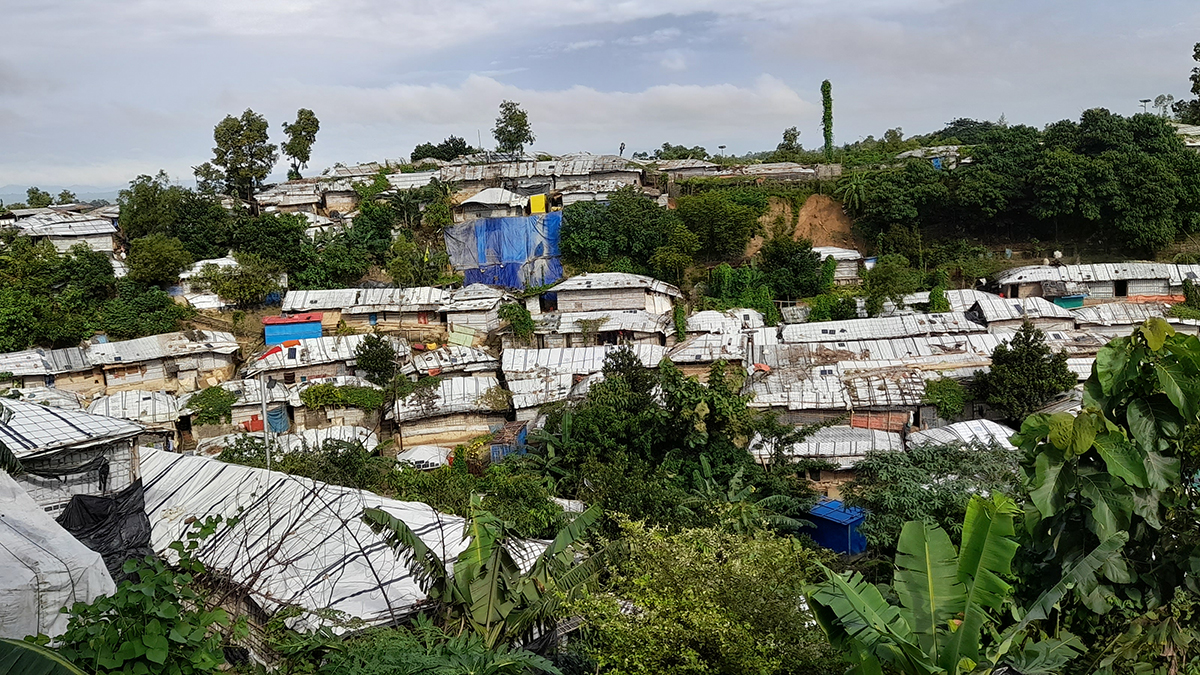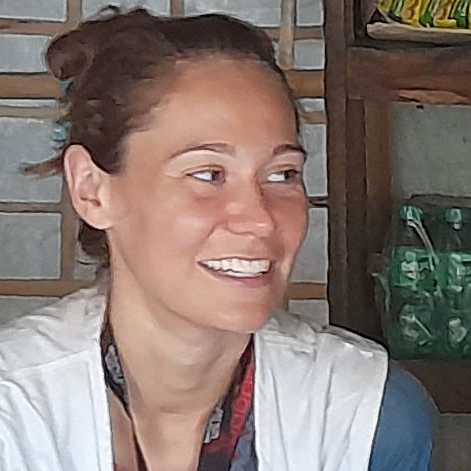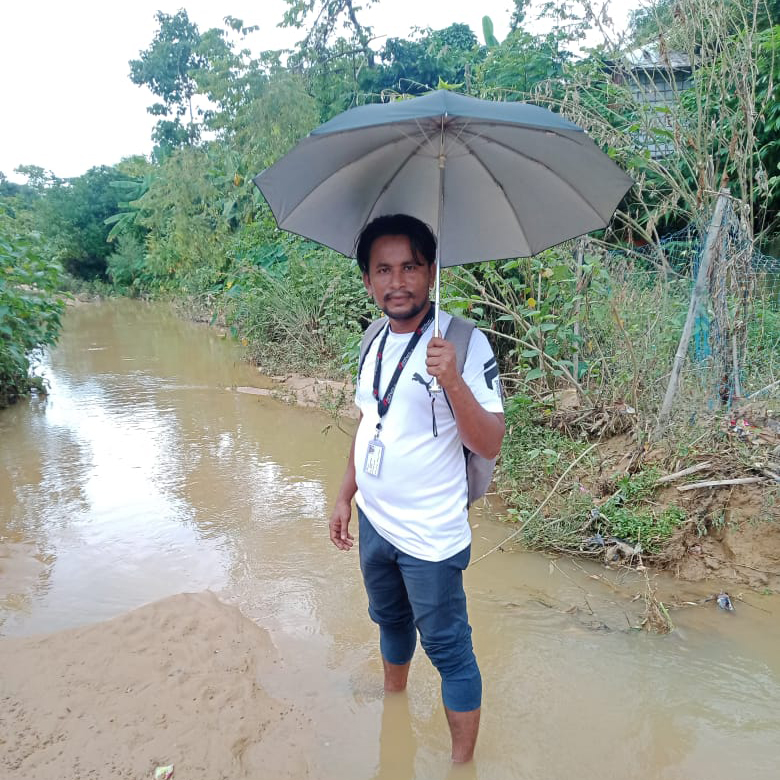Bangladesh: "In the Rohingya refugee camps, life is hard, and hope is fading"
In 2017, violent attacks forced hundreds of thousands of people to flee to Bangladesh. They were Rohingya, an ethnic group who have lived for centuries in north-east Myanmar. Now, almost seven years on, the refugees are surviving in make-shift camps, facing increasingly desolate conditions…
“Most families do not have enough food and they have no livelihood. They have insufficient access to hygiene or health services, little to no access to safe drinking water, and their shelters are vulnerable to natural disasters. These are the main challenges Rohingya face in the camps.”
These words were written by one of my colleagues, Abdul Koyoum, a Rohingya data collector working in the refugee camps in Cox’s Bazar, Bangladesh, where I recently spent six months with Doctors Without Borders / Médecins Sans Frontières (MSF).
Unexpected insights
Abdul has lived in these camps for six-and-a-half years. I read his words as I return from the last day of a sanitation survey done by our team, who were given the onerous task of surveying 380 households across 20 camps to collect information on hygiene, sanitation and disease.
Aware of the many challenges faced by our data collectors as they carried out the household survey, such as torrential rain, landslides, failing smartphones, and even shootings, I’d asked the team to share their feedback on how we could improve the survey process next year. Instead, as I read through the forms, I am confronted with a series of testimonies describing the daily struggles of their lives in the camp.
Sitting in the MSF car as it winds away from the camps - and my Rohingya colleagues - through paddy fields on the road to our guesthouse, I read on. Each narrative is uniquely heartbreaking, and a stark reminder of the broad spectrum of challenges refugees here endure, extending well beyond sanitation issues.
Life in the camps
When around 800,000 people were forced to flee a violent Myanmar military campaign in August 2017, Bangladesh was the only country to open its borders and offer sanctuary to them in the form of makeshift camps. These camps are now ‘home’ to almost one million people, making this the largest settlement of refugees in the world.
More than six years on, life in the camps is becoming increasingly unsustainable, with funding harder to secure and the situation deteriorating as a consequence.
In the camps, the feeling of hopelessness is palpable.
Increasing food and water shortages, high levels of communicable diseases, and a lack of hygiene resources make every day a challenge for people living here. Equally devastating is the lack of opportunities to live a normal life.
Restrictions mean that refugees cannot leave the camps easily, employment is banned, and many children are not receiving proper education. People are almost completely reliant on humanitarian aid.
“Having seen life in the camps, it is impossible for me to imagine the hardships they must have endured in Myanmar if this is their best option.”
Mental health impacts
During the household survey, I noticed that the younger children are bubbly and happy, filled with energy and questions, just like every other child on the planet.
Most of these children were born in the camp, and hence they are somewhat unaware of their circumstances. However, amongst the older children, there is a stark difference in spirit. These older children and adults rarely smile. Life is hard here, and hope for a better life is fading.
As MSF, we do not treat Rohingya patients preferentially over the local Bangladeshi community. But among the consultations provided by our mental health team here, signs of depression or anxiety are more than twice as common among Rohingya patients compared with those from the host community.
Most Rohingya have not been able to return to Myanmar since they fled, due to fear of the brutal consequences they faced there: family members were raped, communities were burned down, and at least 6,700 Rohingya were violently killed.
Having seen life in the camps, it is impossible for me to imagine the hardships they must have endured in Myanmar if this is their best option. Rohingya people now in Bangladesh have little choice but to remain confined within the boundaries of the camps.
3,930
BIRTHS ASSISTED BY MSF IN BANGLADESH IN 2024
624,100
OUTPATIENT CONSULTATIONS IN BANGLADESH IN 2024
3,330
PEOPLE TREATED FOR INTENTIONAL PHYSICAL VIOLENCE IN 2024
Worsening conditions
As an epidemiologist who has spent my career working with large-scale datasets to inform outbreak response and public health policy, my observations in the camps were alarming.
My daily work analysing disease trends across MSF’s several clinics gave me a unique ‘birds-eye’ view of the situation across the camps. The data-based observations I made were continuously reinforced by the stories I heard from Rohingya colleagues and community members.
During my short posting, camp-wide surges of diarrhoea and dengue were just two of the health challenges people here faced, each clearly linked with the worsening living conditions in the camps.
Earlier this year, the World Health Organization estimated that 40 percent of people across the camps had scabies, a skin infection caused by mites which can lead to serious health complications. In some camps the prevalence was over 70 percent.
This prevalence of scabies was unprecedented. However, having seen the dire conditions in the camp, it is hardly surprising.
How can someone avoid contracting scabies when they live in an overcrowded makeshift bamboo shelter with limited access to soap, clean water or healthcare services?
Desperate needs
Presented with this myriad of evidence coming from all possible directions, I find it impossible not to see the desperate need for more resources.
MSF and various other groups provide medical and humanitarian care in the camps, thanks to the generosity of their donors. But this aid is not enough to meet people’s current needs, and for many organisations funds are reducing at a critical time when the community’s needs are growing.
International institutional funders have the means to help the Rohingya people. Rohingya voices must be heard, as right now they are left with very few options.
MSF in Bangladesh
Hundreds of thousands of Rohingya have sought refuge in Bangladesh but now live in a precarious situation.
Médecins Sans Frontières/Doctors Without Borders (MSF) has worked in Bangladesh since 1985 and in 2017 we rapidly scaled up our operations in Cox’s Bazar in response to a massive influx of refugees after a renewed wave of targeted violence by the Myanmar military.
In the overcrowded settlements where most Rohingya live, water and sanitation activities are an important part of our efforts to stop the spread of disease. Our clinic in Cox's Bazar offers comprehensive basic and emergency healthcare to Rohingya refugees and the local community.
We also run inpatient and laboratory services. In Kamrangirchar, a slum area in Dhaka, the capital of Bangladesh, we provide services including reproductive healthcare and support for survivors of sexual violence.


